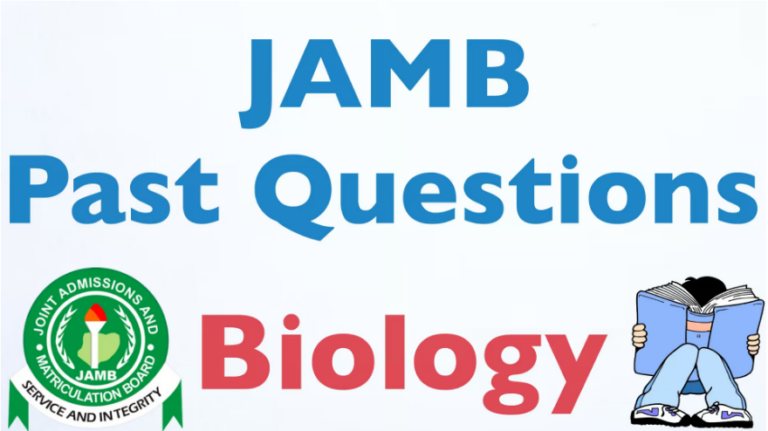JAMB Secret Questions And Answers That Appears Every Year
Table of Contents
Introduction
As a teacher with years of experience preparing students for JAMB, I’ve noticed something fascinating. Year after year, some questions keep appearing in the exams. These are what I like to call JAMB secret questions and answers.
Why are they important? Because they give you an edge! If you know these frequently asked questions, you can prepare smarter, not harder.
In this article, I’m going to share with you the secret questions that show up almost every year in JAMB. These aren’t just guesses—they’re based on patterns I’ve observed over time.
By the time you’re done reading, you’ll have a powerful tool to boost your confidence and improve your chances of success. Let’s dive in!

Why JAMB Secret Questions Are Essential
Every year, students sit for JAMB with hopes of scoring high and securing admission. But did you know there’s a smart way to prepare? Over the years, JAMB has shown a pattern of repeating certain questions. These are what we call JAMB secret questions and answers.
Understanding these questions is like having a cheat code (the legal kind). It helps you focus on the most important areas, saving time and effort. Instead of trying to cram everything, you can concentrate on what really matters.
These secret questions also help you feel more confident. When you walk into the exam hall knowing you’ve prepared with the same types of questions that might appear, it reduces anxiety.
So, don’t ignore the value of JAMB secret questions and answers. They’re a proven tool for smart preparation, and many students swear by them.
Tips for Using JAMB Secret Questions and Answers Effectively
Now that you know the importance of JAMB secret questions and answers, let’s talk about how to use them wisely. It’s not just about reading the questions—you need a strategy!
First, make sure you practice these questions under exam conditions. Time yourself, avoid distractions, and treat it like the real exam. This way, you’ll build both speed and accuracy.
Second, focus on understanding the concepts behind the questions. JAMB often repeats ideas, not just exact questions. For example, if a math question on probability appears one year, expect a similar concept in another year.
Finally, don’t rely solely on these questions. They’re a helpful guide, but you must also study the entire syllabus. Use the JAMB secret questions and answers as a starting point, then expand your knowledge.
With these tips, you’ll make the most of the secret questions and be ready to tackle any surprises JAMB throws your way.
Mathematics – JAMB Secret Questions and Answers
Mathematics is often perceived as a challenging subject, but it is also one of the most predictable in the JAMB exam. Over the years, I’ve noticed certain questions and topics that frequently appear. Focusing on these recurring topics can significantly improve your chances of success.
Below are some JAMB secret questions and answers for Mathematics. Be sure to practice them thoroughly:
- Solve for xxx: 2x−5=3x+72x – 5 = 3x + 72x−5=3x+7.
Ans: x=−12x = -12x=−12 - If xxx and yyy are inversely proportional, and x=12x = 12x=12 when y=4y = 4y=4, find yyy when x=9x = 9x=9.
Ans: y=4y = 4y=4 - Find the derivative of f(x)=3×2−4x+5f(x) = 3x^2 – 4x + 5f(x)=3×2−4x+5.
Ans: f′(x)=6x−4f'(x) = 6x – 4f′(x)=6x−4 - Evaluate the integral ∫(2x+3) dx\int (2x + 3) \, dx∫(2x+3)dx.
Ans: x2+3x+Cx^2 + 3x + Cx2+3x+C - If the ratio of the angles of a triangle is 2:3:4, find the largest angle of the triangle.
Ans: 80∘80^\circ80∘ - Calculate the area of a circle with a radius of 7 cm.
Ans: 154 cm2154 \, \text{cm}^2154cm2 - Solve the quadratic equation x2−5x+6=0x^2 – 5x + 6 = 0x2−5x+6=0.
Ans: x=2x = 2x=2 or x=3x = 3x=3 - Find the sum of the first 10 terms of the arithmetic sequence 2, 5, 8, 11, …
Ans: 165 - Determine the value of xxx in the equation log(x)+log(2)=1\log(x) + \log(2) = 1log(x)+log(2)=1.
Ans: x=5x = 5x=5 - If sin(θ)=35\sin(\theta) = \frac{3}{5}sin(θ)=53, find cos(θ)\cos(\theta)cos(θ).
Ans: cos(θ)=45\cos(\theta) = \frac{4}{5}cos(θ)=54
These are just a few examples of the types of questions you can expect in the exam. Focus on topics like algebra, calculus, trigonometry, and geometry, as they are commonly tested. Practice these JAMB secret questions and answers and explore similar problems to enhance your confidence.
English Language – JAMB Secret Questions and Answers
English Language is the backbone of every JAMB exam. Since it’s compulsory for all candidates, it’s essential to prepare well. The good news is, many questions are repeated or follow the same pattern year after year.
Here are some JAMB secret questions and answers for English Language:
- Identify the synonym of “benevolent.”
Ans: Kind - Choose the correct option to fill in the blank: “She is proficient ___ playing the piano.”
Ans: At - Find the correct spelling: “accommodate, acomodate, acommodate.”
Ans: Accommodate - Determine the meaning of the idiom: “Break the ice.”
Ans: To initiate conversation in a social setting - What is the passive voice of: “The teacher marked the scripts”?
Ans: The scripts were marked by the teacher.
Focus on key areas like synonyms, antonyms, grammar, and comprehension passages. These are the building blocks of the English Language exam. By practicing these JAMB secret questions and answers, you’ll not only improve your chances but also enhance your overall language skills.
Physics – JAMB Secret Questions and Answers
Physics is one of the key subjects in the JAMB exam that tests your understanding of fundamental principles and their real-world applications. The questions typically cover a broad range of topics, and many questions are repeated year after year. By focusing on these common questions, you can improve your chances of performing well in the exam.
Frequently Asked JAMB Physics Questions
- State Newton’s second law of motion.
- Answer: F=maF = maF=ma
Newton’s second law relates the force applied to an object to its mass and acceleration.
- Answer: F=maF = maF=ma
- Calculate the acceleration of a 5 kg mass acted upon by a 20 N force.
- Answer: a=4 m/s2a = 4 \, \text{m/s}^2a=4m/s2
Using the formula F=maF = maF=ma, we rearrange to find a=F/ma = F/ma=F/m, which gives 20/5=4 m/s220/5 = 4 \, \text{m/s}^220/5=4m/s2.
- Answer: a=4 m/s2a = 4 \, \text{m/s}^2a=4m/s2
- Define the term “half-life” in radioactivity.
- Answer: The time taken for half of the radioactive nuclei in a sample to decay.
- Explain the Doppler effect.
- Answer: The apparent change in frequency or wavelength of a wave due to the relative motion between the source and the observer.
- Calculate the frequency of a wave with a period of 0.2 seconds.
- Answer: 5 Hz
Using the formula f=1/Tf = 1/Tf=1/T, where T=0.2T = 0.2T=0.2, we get f=1/0.2=5 Hzf = 1/0.2 = 5 \, \text{Hz}f=1/0.2=5Hz.
- Answer: 5 Hz
- State Ohm’s law.
- Answer: V=IRV = IRV=IR
Ohm’s law relates the voltage (VVV) across a conductor to the current (III) flowing through it and the resistance (RRR) of the conductor.
- Answer: V=IRV = IRV=IR
- Determine the equivalent resistance of resistors 4 Ω and 6 Ω in series.
- Answer: 10 Ω
For resistors in series, the total resistance is the sum of individual resistances: Rtotal=4+6=10 ΩR_{\text{total}} = 4 + 6 = 10 \, \OmegaRtotal=4+6=10Ω.
- Answer: 10 Ω
- Explain the principle of conservation of linear momentum.
- Answer: The total momentum of a closed system remains constant if no external forces are acting on it. Momentum before interaction equals momentum after interaction.
- Calculate the kinetic energy of a 2 kg object moving at 3 m/s.
- Answer: 9 J
Using the formula for kinetic energy KE=12mv2KE = \frac{1}{2} mv^2KE=21mv2, we get KE=12×2×32=9 JKE = \frac{1}{2} \times 2 \times 3^2 = 9 \, \text{J}KE=21×2×32=9J.
- Answer: 9 J
- Define refractive index.
- Answer: The ratio of the speed of light in a vacuum to the speed of light in a medium.
- What is the SI unit of electric charge?
- Answer: Coulomb (C).
- State the first law of thermodynamics.
- Answer: Energy cannot be created or destroyed, only transformed from one form to another.
- Calculate the work done when a force of 10 N moves an object 5 m.
- Answer: 50 J
Using the formula W=F×dW = F \times dW=F×d, where F=10 NF = 10 \, \text{N}F=10N and d=5 md = 5 \, \text{m}d=5m, we get W=10×5=50 JW = 10 \times 5 = 50 \, \text{J}W=10×5=50J.
- Answer: 50 J
- What is the speed of light in a vacuum?
- Answer: 3×108 m/s3 \times 10^8 \, \text{m/s}3×108m/s.
- Define specific heat capacity.
- Answer: The amount of heat required to raise the temperature of 1 kilogram of a substance by 1°C.
- What is the wavelength of a sound wave with a speed of 340 m/s and a frequency of 170 Hz?
- Answer: 2 m
Using the formula v=fλv = f \lambdav=fλ, where v=340 m/sv = 340 \, \text{m/s}v=340m/s and f=170 Hzf = 170 \, \text{Hz}f=170Hz, we solve for λ=vf=340170=2 m\lambda = \frac{v}{f} = \frac{340}{170} = 2 \, \text{m}λ=fv=170340=2m.
- Answer: 2 m
- State the SI unit of power.
- Answer: Watt (W).
- What is the charge of an electron?
- Answer: −1.6×10−19 C-1.6 \times 10^{-19} \, \text{C}−1.6×10−19C.
- Define amplitude.
- Answer: The maximum displacement of a wave from its equilibrium position.
- What is the unit of magnetic flux?
- Answer: Weber (Wb).
Key Physics Topics Covered
- Mechanics (Newton’s Laws, acceleration, kinetic energy)
- Electricity (Ohm’s law, resistance, power)
- Waves (frequency, wavelength, Doppler effect)
- Thermodynamics (first law, work done)
- Optics (refractive index)
By studying these questions and understanding the underlying concepts, you’ll be well-prepared for the physics section of your JAMB exam. Keep practicing these types of questions, and make sure to focus on the key topics to maximize your performance.
Chemistry – JAMB Secret Questions and Answers
Chemistry is a crucial part of the JAMB exam, particularly for students pursuing courses in the sciences and medical fields. JAMB chemistry questions often test your understanding of fundamental concepts such as the periodic table, bonding, and reactions. Here are 20 commonly repeated chemistry questions.
Frequently Asked JAMB Chemistry Questions
- What is the atomic number of oxygen?
- Answer: 8
- Define isotope.
- Answer: Atoms of the same element with different mass numbers.
- State the electronic configuration of sodium.
- Answer: 1s2 2s2 2p6 3s11s^2 \, 2s^2 \, 2p^6 \, 3s^11s22s22p63s1
- What is the pH of a neutral solution?
- Answer: 7
- Name the gas evolved when zinc reacts with hydrochloric acid.
- Answer: Hydrogen
- Define valency.
- Answer: The combining power of an element.
- What type of bond exists in sodium chloride?
- Answer: Ionic bond.
- State Avogadro’s law.
- Answer: Equal volumes of gases contain the same number of molecules at the same temperature and pressure.
- Name the process of converting a liquid to gas at its boiling point.
- Answer: Vaporization.
- Define oxidation.
- Answer: The loss of electrons or an increase in oxidation state.
- What is the molecular formula of glucose?
- Answer: C6H12O6C_6H_{12}O_6C6H12O6
- Name the acid present in vinegar.
- Answer: Acetic acid.
- What is the molar mass of carbon dioxide?
- Answer: 44 g/mol.
- State the main component of natural gas.
- Answer: Methane.
- What is the principle of chromatography?
- Answer: Separation based on differences in solubility and adsorption.
- Name the ore of aluminum.
- Answer: Bauxite.
- What is the shape of a methane molecule?
- Answer: Tetrahedral.
- What is the main product of the Haber process?
- Answer: Ammonia.
- Define electrolysis.
- Answer: Chemical decomposition by passing an electric current.
- What is the common name for H2SO4H_2SO_4H2SO4?
- Answer: Sulfuric acid.
Key Chemistry Topics Covered
- Atomic structure and periodic table
- Chemical bonding (ionic, covalent)
- Chemical reactions (oxidation, vaporization)
- Organic chemistry (glucose, methane, Haber process)
Studying these frequently asked questions will give you a strong foundation in chemistry and help you tackle a significant portion of the JAMB exam. Be sure to also practice problem-solving to strengthen your understanding.
Biology – JAMB Secret Questions and Answers
Biology is often a favorite subject for many students, especially for those aiming for health-related courses. JAMB biology questions focus on understanding life processes, ecosystems, genetics, and human biology. Let’s take a look at 20 commonly asked biology questions.
Frequently Asked JAMB Biology Questions
- What is the functional unit of the kidney?
- Answer: Nephron
- Name the powerhouse of the cell.
- Answer: Mitochondrion
- Define osmosis.
- Answer: Movement of water from a region of low solute concentration to high solute concentration through a semi-permeable membrane.
- What is the chemical formula for glucose?
- Answer: C6H12O6C_6H_{12}O_6C6H12O6
- Name the pigment responsible for photosynthesis.
- Answer: Chlorophyll
- What is the mode of nutrition in fungi?
- Answer: Saprophytic
- State the main function of red blood cells.
- Answer: Transport oxygen
- What type of skeleton do humans have?
- Answer: Endoskeleton
- Define transpiration.
- Answer: Loss of water vapor from plants.
- Name the largest organ in the human body.
- Answer: Skin.
- What is the main function of the stomata?
- Answer: Gas exchange.
- What is the basic unit of inheritance?
- Answer: Gene.
- Name the disease caused by the deficiency of vitamin C.
- Answer: Scurvy.
- What is the primary source of energy for life?
- Answer: Sun.
- Define asexual reproduction.
- Answer: Reproduction without the involvement of gametes.
- What is the role of insulin in the body?
- Answer: Regulates blood sugar levels.
- What is the difference between plant and animal cells?
- Answer: Plant cells have a cell wall and chloroplasts, animal cells do not.
- What is the process by which plants make food?
- Answer: Photosynthesis.
- What is the main cause of malaria?
- Answer: Plasmodium parasite, transmitted by Anopheles mosquitoes.
- What is the function of the ribosome in the cell?
- Answer: Protein synthesis.
Key Biology Topics Covered
- Cell biology (mitochondria, ribosomes, cell structure)
- Plant biology (photosynthesis, transpiration)
- Human biology (red blood cells, insulin)
- Genetics and inheritance (genes, reproduction)
Mastering these questions and topics will help you excel in the biology section of JAMB.
Government – JAMB Secret Questions and Answers
Government is a crucial subject for students aiming to study courses related to the arts, social sciences, and political science. Understanding the recurring themes in government questions is essential for mastering this part of the JAMB exam.
Why Government Questions Are Important:
Government questions test your knowledge of the political and civic systems of Nigeria and the world. They often examine your understanding of key political structures, principles, and events that shape governance.
Frequently Repeated Questions in Government:
Here are 20 of the most frequently asked government questions with answers:- What is the Constitution?
- Answer: The Constitution is the supreme law of a country that defines the political system and the rights of citizens.
- What is Democracy?
- Answer: Democracy is a system of government where the people exercise their power through elected representatives.
- Who is the head of state in Nigeria?
- Answer: The President of Nigeria.
- What is federalism?
- Answer: A system of government in which power is divided between a central government and regional governments.
- What is the role of the National Assembly?
- Answer: The National Assembly is responsible for making laws for the country.
- What are the duties of the executive in a democracy?
- Answer: The executive is responsible for implementing and enforcing laws, managing national affairs, and ensuring the welfare of citizens.
- Define the term ‘bicameral legislature’.
- Answer: A bicameral legislature is a two-chamber legislature, consisting of an upper and lower house.
- Who were the founding fathers of Nigerian independence?
- Answer: Nnamdi Azikiwe, Obafemi Awolowo, and Ahmadu Bello.
- What is the role of the judiciary in a democracy?
- Answer: The judiciary interprets the law and ensures justice is served fairly.
- What are political parties?
- Answer: Political parties are organized groups of people who seek to gain political power and implement their agenda through elections.
- What is the principle of separation of powers?
- Answer: The separation of powers ensures that the government’s powers are divided into three branches: executive, legislature, and judiciary.
- Explain the concept of rule of law.
- Answer: Rule of law is the principle that everyone, including the government, is subject to the law.
- What is universal suffrage?
- Answer: Universal suffrage is the right of all adult citizens to vote in elections.
- What is an international organization?
- Answer: An international organization is an institution that promotes cooperation among different nations on various issues, such as the United Nations.
- What is political corruption?
- Answer: Political corruption is the abuse of power by government officials for personal gain.
- What is the significance of the Nigerian Electoral Commission?
- Answer: The Independent National Electoral Commission (INEC) is responsible for organizing and overseeing elections in Nigeria.
- What is the meaning of ‘checks and balances’?
- Answer: Checks and balances is a system that ensures no branch of government becomes too powerful by allowing each branch to limit the powers of the others.
- What are the functions of political parties in a democracy?
- Answer: Political parties organize elections, represent different ideologies, and serve as intermediaries between the government and citizens.
- What is a constitution amendment?
- Answer: A constitution amendment is the process of making changes to a country’s constitution to address new needs or challenges.
- What is the difference between a parliamentary system and a presidential system?
- Answer: In a parliamentary system, the executive is drawn from the legislature, while in a presidential system, the executive is separate from the legislature.
- What is the Constitution?
- Key Topics Covered:
- Constitution, democracy, federalism, separation of powers, and the role of government branches.
- Understanding political ideologies, political parties, and governance systems.
How to Identify JAMB Secret Questions and Answers Yourself
It’s important to understand how to find recurring questions and use them to your advantage. Knowing how to analyze past JAMB questions can save time and ensure your preparation is focused on what matters most.
- Analyze Past JAMB Questions:
One of the best ways to identify “JAMB secret questions and answers” is to go through past JAMB question papers. Look for patterns in the types of questions asked, and pay attention to how certain topics are emphasized year after year. - Why Patterns Matter:
JAMB questions often follow a predictable pattern, especially in subjects like Mathematics, English, Physics, and Chemistry. By identifying these patterns, you can focus your study efforts on the topics that are most likely to appear in the exam. - Studying Past Question Compilations:
Invest in good past question compilations that provide a broad range of previously asked questions. These resources often highlight frequently repeated questions, allowing you to focus on the most critical topics. - Accessing Authentic Past Question Resources:
Authentic past question resources can be found in bookstores, online platforms, and educational centers. You can also check official JAMB websites for downloadable past questions. Be cautious of unreliable sources to ensure you’re using accurate materials. - Developing a Strategy:
Once you’ve gathered enough past questions, create a study plan that focuses on high-yield topics. Regularly test yourself with these questions to gauge your progress and refine your strategy.
Conclusion
Mastering JAMB secret questions and answers can significantly improve your chances of excelling in the exam. However, it’s essential to balance your preparation by also studying the entire syllabus thoroughly.
- Recap of the Value:
Focusing on JAMB secret questions helps you identify the most likely questions that will appear, boosting your confidence and ensuring your preparation is efficient. These questions serve as a great way to test your understanding and reinforce key concepts. - Encouragement to Balance Preparation:
While JAMB secret questions are a valuable tool, they should not be the sole focus of your study routine. Ensure you cover the entire syllabus and engage with a variety of study materials. - Call-to-Action:
Share this article with friends, family, or fellow students who are also preparing for JAMB. Join online study groups or forums to discuss tips, share resources, and learn from others’ experiences. The more prepared you are, the better your chances of success!
FAQs
- What are JAMB secret questions and answers?
- JAMB secret questions and answers are recurring questions that have appeared in previous JAMB exams. These questions often follow a predictable pattern and are highly likely to be repeated in future exams.
- Can I rely solely on these questions to pass JAMB?
- While focusing on these questions can boost your chances, it’s essential to study the entire syllabus to ensure comprehensive preparation.
- Where can I get authentic past questions?
- Authentic past questions can be found at reputable bookstores, educational centers, or official JAMB platforms.
- How accurate are these questions in predicting actual JAMB questions?
- JAMB secret questions are based on trends and are highly accurate in predicting what will appear in future exams, although new questions may also be introduced.
- Are these questions available for all subjects?
- Yes, JAMB secret questions are available for major subjects such as Mathematics, English, Physics, Chemistry, Biology, and Government.




